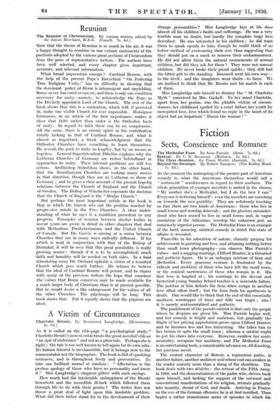Reunion
The Reunion of Christendom. By various writers, edited by Sir James Marchant, K.B.E. (Cassell. 7s. 6d.)
Now that the theme of Reunion is so much in the air, it was a happy thought to combine in one volume statements of the positions adopted by the various great sections of Christendom from the pens of representative writers. The authors have been well selected, and every chapter gives important, accurate, and relevant information.
What broad impressions emerge ? Cardinal Bourne, with the help of the present Pope's Encyclical " On Fostering. True Religious Unity," has no difficulty in showing that the dominant policy at Rome is intransigent and unyielding. Rome never has erred or can err, and there is only one condition necessary for unity—namely, to acknowledge the Pope as the Divinely appointed Lord of the Church. The rest of the book shows that this is a contention, which will, if persisted in, make one visible Church for ever impossible. Monsignor Germanos, in an article of the first importance, makes it clear that faith rather than order is the Orthodox basis of unity. In regard to faith there can be no compromise. All the same, there is an eirenic spirit in his contribution totally lacking in that of Cardinal Bourne, and, what is almost as important, a frank acknowledgment that the Orthodox Churches have something to learn themselves. He reveals the path to unity as lengthy, but by no means as hopeless. General-Superintendent Dibelius explains why the Lutheran Churches of Germany are rather behindhand in approaches to unity. Their internal problems are still too serious. Archbishop Soderblom shows, on the other hand, that the Scandinavian Churches are making many moves in that direction, though they are as Lutheran as those of Germany ; and he gives a clear account of the present hopeful relations between the Church of England and the Church of Sweden. The Bishop of Winchester expounds the doctrine that the Church of England is the " Bridge Church."
But perhaps the most important article in the book is that in which Dr. Garvie sets out the position reached by progressive minds in the Free Churches. A clear under- standing of what he says is a condition precedent to any progress. Examples of reunion between similar bodies in recent years are given in detail in other chapters that deal with Methodism, Presbyterianism, and the United Church of Canada. But Dr. Garvie is aiming at a union between Churches that are in many ways radically different. If his article is read in conjunction with that of the Bishop of Dornakal, it will be seen that this great possibility is really growing nearer ; though if it is to be accomplished, much faith and humility will be needed on both sides. In a final stimulating essay Dr. Orchard upholds a vision of a reunited Church which goes much further. He refuses to believe that the ideal of Cardinal Bourne will persist, and he shares with many of the previous writers the hope that somehow the values that Rome conserves may be made available for a much larger body of Christians than is at present possible. But he would desire a like enlargement for the values of all the other Churches. The pilgrimage will be long. This book shows that. But it equally shows that the pilgrims are afoot.






































 Previous page
Previous page